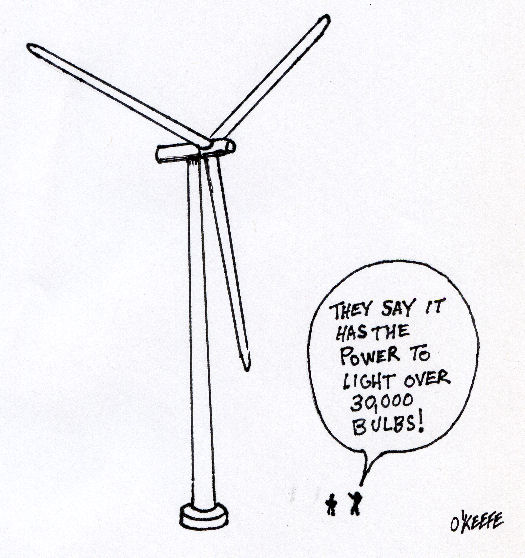|
Alternative energy is a hot topic today. There are certainly benefits to be gained by replacing fossil fueled power plants with alternative energy sources. One of the most publicized of these is the free energy that is generated by wind turbines that drive electric generators. Surely this is a win-win situation? Let’s take a closer look! If you’ve been out in the country within the last few years you’ve surely seen the new generation of windmill. These mammoths are so large and intimidating they remind me of the cartoon robot, Gigantor, popular back in the 1960s—scary until you get to know him. Yes, these wind turbines are big, and so is their cost. They are so expensive that a return on investment is a rather long way off. Let’s examine the numbers. A 2 megawatt wind turbine can cost over $2 million to purchase and install. By 2 megawatt, I mean two million watts of output. The generator on this baby can produce enough power to light around 33,330 sixty watt bulbs. If I were to install one on my property, my local electric utility would be willing to pay me approximately $10,000 per month to buy its power from me. At this rate of compensation, it would take over 16 years to realize a return on my investment. That’s the “looks good on paper” figure. Realistically speaking, it would actually take a lot longer than 16 years if we factor in the cost of maintenance and the interest rates on borrowed money. So what happens if the Gigantor in your back yard needs servicing? I did some checking, and it’s not cheap. It can cost as much as $15,000 just to hire the massive crane that is required to lift the heavy parts involved. Aside from purchase price and maintenance expenses, another thing to consider when talking installation of wind turbines is the fact that they operate at the mercy of Mother Nature. No wind, no power. Is there anything we can do to compensate for this factor, like store the energy generated on a windy day for future usage? This would be a great solution, if only battery technology was economical enough for storage of the vast amounts of energy that is required to power an electric utility grid if the wind stops blowing for an extended period of time. For example, sodium battery technology is up to the task, but the cost is high, at around $3,500.00 per kilowatt-hour. At this price a 2 megawatt wind turbine would need about $7 million worth of storage just to get us through about one hour of calm weather! Now here’s a proposed solution to the storage issue that you may have read about. It involves utilizing storage systems which would use electric motors to convert the electrical energy from the turbine generators into mechanical energy. This energy would then be transferred to mechanical storage devices, such as a huge flywheel. Then, if the wind stops blowing and power stops flowing, the motor on the flywheel can be turned into an electric generator. The mechanical energy stored in its spinning mass would power the generator, which would in turn keep electricity flowing into the power grid. Now remember, the amount of mechanical energy we can store in a flywheel spinning at a given speed depends on its mass, that is, how heavy it is. The more energy we have to store, the heavier the flywheel has to be. So when we’re talking about storing many millions of watts of energy to get us through several days of calm weather, we’d have to make a flywheel so massive it would be impractical and uneconomical to build. Just to store about one hour’s worth of energy from our 2-megawatt wind turbine we’d need to build a flywheel over 65 feet in diameter that spins at 1800 rpm and weighs more than 9 tons. Another proposal to store the wind turbine’s energy involves the use of electric motors to drive air compressors that would pressurize caverns deep below the earth’s surface. This effectively creates what is called a compressed-air energy storage (CAES) facility. The idea here is that when the wind stops, the motors would act as generators and the compressors would act as air turbines. This pressurized air could then be drained from the caverns in which it is stored and redirected to flow through the turbine. Then, finally, the stored mechanical energy in the pressurized air would be converted by the air turbine and generator back into electrical energy to power the grid. At best, a CAES facility will run at about 70% efficiency. That means for every 100 kilowatt-hours of energy you put into storage, you only receive 70 kilowatt-hours in return. Once examined, it seems that current technology does not provide a cost-feasible solution for the replacement of fossil fuel backed energy with wind turbine energy. So where do we go from here? We’ll continue our exploration of alternative energy next week. _________________________________________________________________ |
Engineering Expert Witness Blog
Published by Philip J. O'Keefe, PE, MLE




